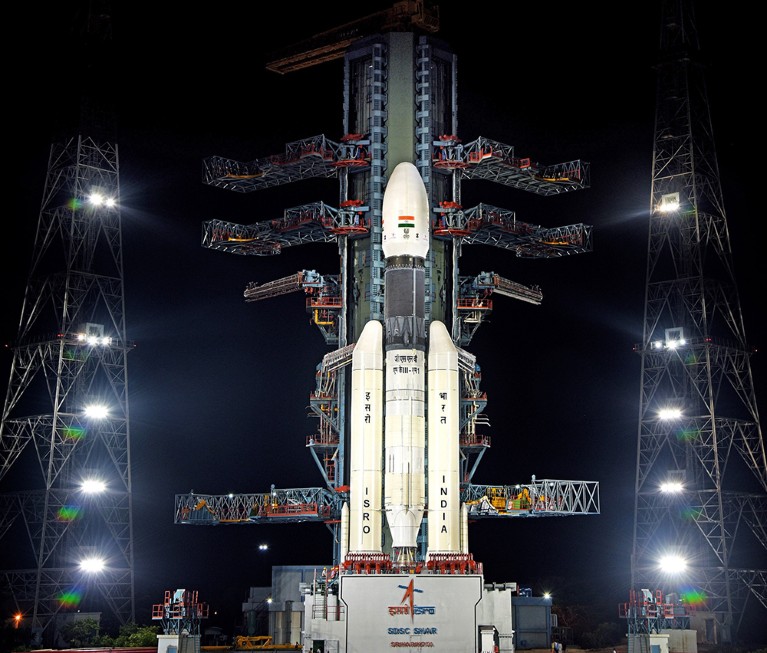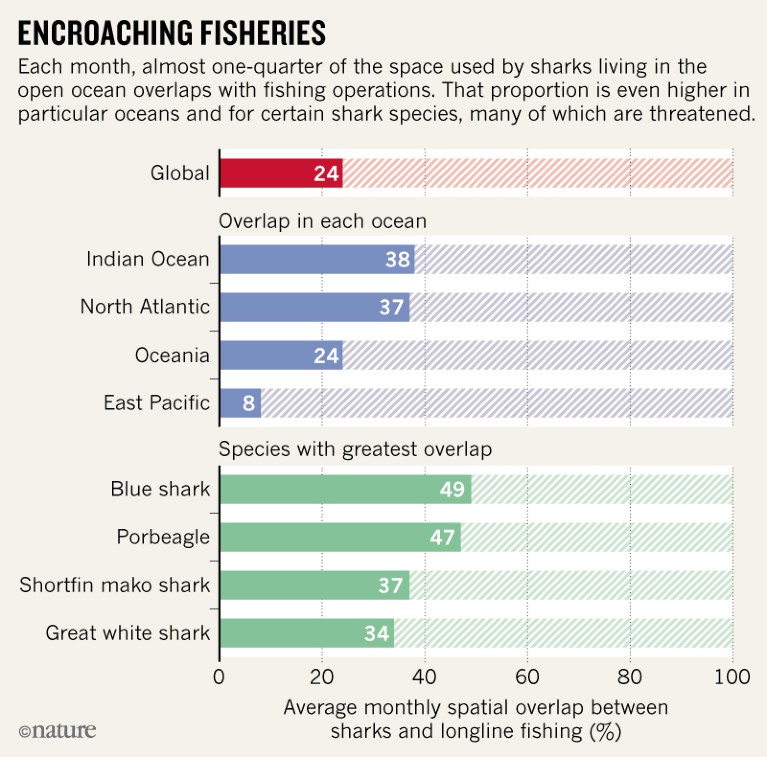SPACE
India’s ambitious Moon mission lifts off India launched its second Moon mission on 22 July, a week after it halted a launch attempt because of a rocket-engine leak. The US$141-million Chandrayaan-2 spacecraft lifted off on an Indian rocket from a site on the edge of the Bay of Bengal. The mission marks the nation’s first attempt to make a ‘soft’ landing on the Moon — a feat so far achieved only by the United States, Russia and China. The spacecraft comprises an orbiter and a lander that is heading for the uncharted lunar south pole. In all, it carries 14 scientific instruments — 13 Indian and one from NASA — which will study rocks, soils, the atmosphere and lunar minerals. The lander, called Vikram, is scheduled to touch down in September and release a six-wheeled rover called Pragyan that can explore for a distance of up to 500 metres.

India’s second Moon mission Chandryaan-2 launched from a site on the edge of the Bay of Bengal.Credit: ISRO
Space lab burns up China’s orbiting space laboratory Tiangong-2 came to a fiery end in an operation that saw its remnants crash into the Pacific Ocean on 19 July. The bus-sized laboratory, which was launched in September 2016, tested a series of technologies as part of the country’s growing human space-flight programme and supported 2 astronauts for 30 days. Tiangong-2 exceeded its planned 2-year life and hosted a range of scientific experiments, including an atomic clock and a γ-ray telescope. Unlike its predecessor, Tiangong-1, which plummeted to Earth in an uncontrolled descent in 2018, China’s space agency deliberately brought Tiangong-2 out of orbit to burn up in the atmosphere. China is designing its first major space station, which is expected to begin operations in 2022.
FACILITIES
LHC releases data The CMS experiment at the Large Hadron Collider (LHC) has made 2,000 terabytes of its data public in a bid to boost analysis efforts that use machine learning. The data represent proton collisions recorded in 2010 by CMS — one of the LHC’s two major detectors at CERN, Europe’s particle-physics laboratory near Geneva, Switzerland. CMS physicists hope that the data troves will help machine-learning researchers to refine algorithms that might aid the discovery of new particles or other deviations from the standard model of particle physics. It is CMS policy to release data to the public within ten years of collection; it opened up part of its 2010 data in 2014. The other LHC detector, ATLAS, has also made data public.
RESEARCH
Storm science A cluster of cameras peering down at Earth from the International Space Station has spotted hundreds of γ-ray flashes going off in the hearts of thunderstorms. Space physicists have begun to unravel how the high-energy bursts arise by comparing them with lightning rippling through the same storms. Data from the Atmosphere–Space Interactions Monitor (ASIM), a box-shaped set of cameras and sensors, has revealed that the bursts form when powerful electric fields course through the atmosphere, just before a lightning bolt travels along the same path. The charged electrical particles interact with the atmosphere to produce a superfast flickering of γ-rays. Scientists reported the findings at the International Union of Geodesy and Geophysics meeting in Montreal, Canada, on 9 and 12 July.
EVENTS
Ebola emergency The worsening Ebola outbreak in the Democratic Republic of the Congo (DRC) is a public-health emergency of international concern, the World Health Organization (WHO) said on 17 July. The declaration is the WHO’s highest level of alarm, and signals an event that poses a risk to multiple countries and that requires a coordinated international response. The move came amid renewed fears that the virus could spread beyond the DRC’s borders, after reports of people with the virus travelling into areas beyond the outbreak zone. More than 2,500 people have become ill and some 1,700 have died during the DRC outbreak, making it the second-worst on record. The WHO’s investigations have suggested that the virus began spreading in the eastern DRC a few months before the outbreak was declared in August 2018.
Telescope protest Hundreds of protestors have again blocked construction of the Thirty Meter Telescope (TMT) on Mauna Kea in Hawaii, saying that the project will further despoil a sacred mountain. Thirteen astronomical observatories on the summit — including some of the world’s largest, such as the twin 10-metre Keck telescopes — stopped collecting data and ordered employees and researchers to evacuate on 16 July. Normal operations will resume “as soon as the situation allows”, said Jessica Dempsey, deputy director of the James Clerk Maxwell Telescope. Work on the TMT was set to restart on 15 July after a four-year delay caused by legal challenges and protests. Hawaii’s state supreme court ruled in October that the TMT’s construction permit was valid. But on 13 July, protestors (pictured) began gathering at the base of the access road that leads up Mauna Kea. Police took 33 Native Hawaiian elders into custody on 17 July before ticketing them and releasing them that day.

Protests against the construction of a telescope on Mauna Kea shut down observatories on the Hawaiian mountain.Credit: Caleb Jones/AP/Shutterstock
Moon tapes auction Three reels of NASA videotape depicting the Apollo 11 Moon landing sold at a New York City auction for US$1.8 million on 20 July, the 50th anniversary of the landing. Former NASA intern Gary George had bought the tapes — part of a collection of more than 1,000 reels the agency owned — in a government surplus auction in 1973 for $217.77. He only realized their significance a little more than a decade ago. They contain 2 hours and 24 minutes of footage, including Neil Armstrong stepping onto the Moon and the astronauts raising the American flag on the lunar surface. The tapes have been viewed only three times and are among the most pristine surviving recordings of the historic Moon walk. Sotheby’s, which ran the auction, did not disclose the name of the buyer.
UNIVERSITIES
Physicist sacked The Swiss Federal Institute of Technology in Zurich (ETH Zurich) has fired astrophysicist Marcella Carollo over bullying allegations — the first time in its 164-year history that it has dismissed a tenured professor. In early 2017, a dozen current and former PhD students of Carollo’s wrote testimonials complaining of bullying and being placed under excessive pressure. The university commissioned an investigation by an external lawyer who concluded last year that Carollo had harassed the students and recommended her dismissal. Carollo disputes all allegations of bullying, and her lawyer told Nature that he is considering appealing against the dismissal in court. In its 15 July statement announcing the move, ETH Zurich acknowledged that its procedures for handling such cases had been flawed. The university pledged to expand its ombudsman’s office and ensure that future doctoral students have at least two supervisors.
CLIMATE
Hottest June Last month was the hottest June on record, according to data from the US National Oceanic and Atmospheric Administration (NOAA). The average temperature across the world’s land and ocean surfaces was 16.45 °C, nearly a degree more than the twentieth-century average for the month. Arctic sea ice was also at its second-lowest extent recorded for June. NOAA’s findings echo those of other weather agencies, such as the European Union’s Copernicus Climate Change Service and the Japan Meteorological Agency. According to analyses by climate scientists including Michael Mann at Pennsylvania State University in University Park, July is also likely to break temperature records. If this happens, it will be the hottest month ever recorded on Earth.
TREND WATCH
Sharks that live in the open ocean are being forced to share large parts of their habitat with fisheries, an analysis has found. Pelagic sharks live in open waters and many species migrate long distances each year. To track their movements, a team led by David Sims at the Marine Biological Association of the United Kingdom in Plymouth tagged almost 1,700 pelagic sharks with satellite transmitters between 2002 and 2017. The team charted the movements of longline fishing vessels using data from ships’ automatic identification systems. In an average month, 24% of the area of the ocean used by sharks overlapped with the area of longline fishing operations, but in some regions the overlap was even higher. The results demonstrate that sharks don’t have many options when it comes to seeking refuge from fisheries, say the authors, who suggest creating protected areas around important shark hotspots. This is particularly important because many species of pelagic shark are considered threatened. Longline fishing uses lines that can include hundreds of hooks and span 100 kilometres. It is the fishing practice that catches the most pelagic sharks.

Source: N. Queiroz et al. Nature https://doi.org/10.1038/s41586-019-1444-4 (2019).






